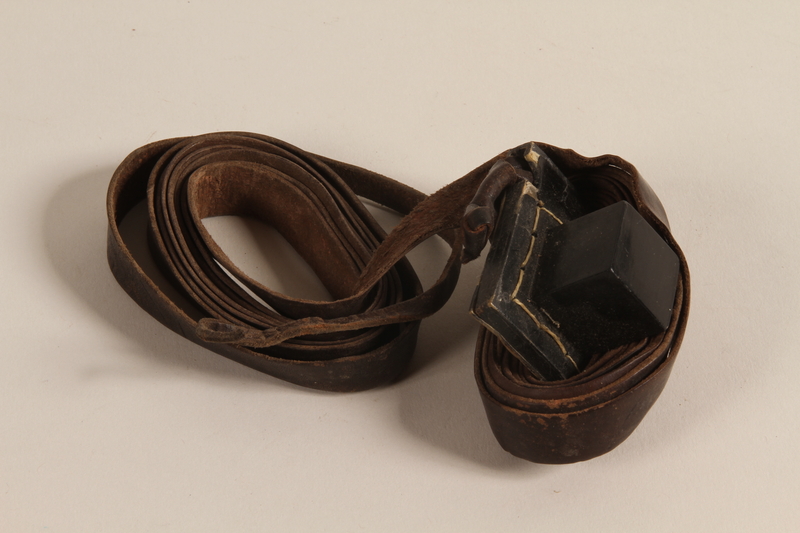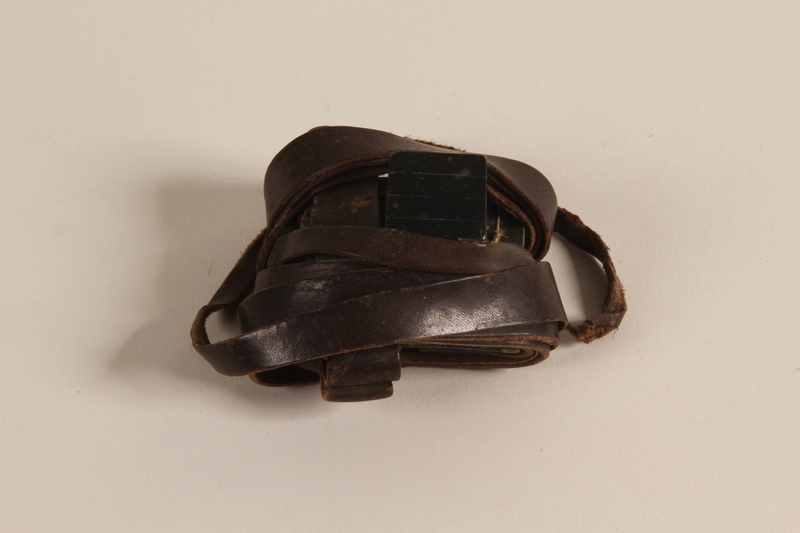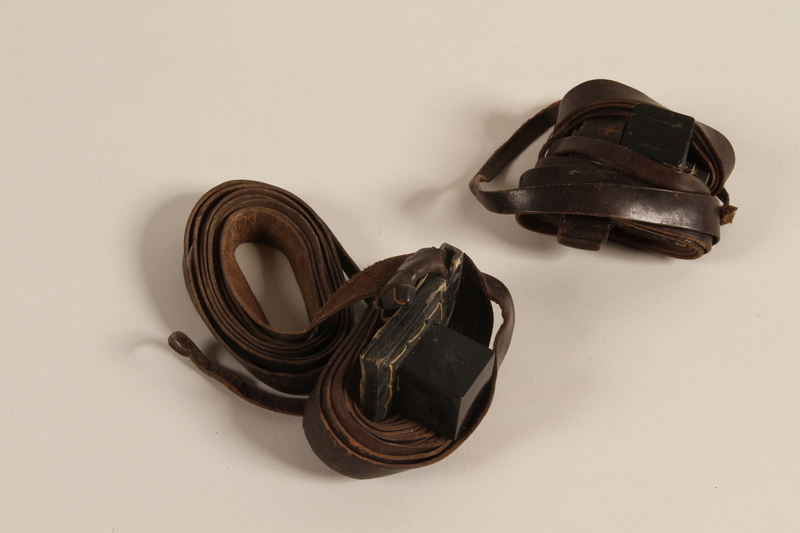Overview
- Brief Narrative
- Tefillin set taken by Michael [Mojsej] Garber, 21, when he fled Warsaw, Poland, for Soviet territory soon after the September 1939 German invasion. Tefillin are small boxes containing prayers attached to leather straps and worn on the arm and the head by Jewish males during morning prayers. Michael received these tefillin from his parents when he was a 12 year old boy preparing for bar mitzvah. He kept them in a small pouch and took them with him, along with his prayer book, when he escaped. The Soviet authorities sent him to a labor camp but when Germany invaded the Soviet Union in June 1941, he convinced them to let him work as a physician's assistant. In February 1945, when Poles were allowed to leave Soviet territory, he was a physician for 5 collective farms in Uzbekistan. Michael agreed to marry another Polish refugee and physician, Ella Dworecka, so that her family could return to Poland. Her father promised they could divorce after the journey, but Michael and Ella chose to remain together. Michael's parents, Aron and Frajda, and his sister Bronja and her husband Sam Duvorestki perished during the war.
- Date
-
received:
approximately 1930
- Geography
-
received:
Warsaw (Poland)
- Credit Line
- United States Holocaust Memorial Museum Collection, Gift of Michael Garber
- Markings
- b. left and right sides, embossed : ש
- Contributor
-
Subject:
Michael M. Garber
- Biography
-
Michael, originally Mojsej, Garber was born on December 31, 1918, in Warsaw, Poland, to Aron and Frajda Pentman Garber. Aron was born in 1883 in Rozana, Poland, then part of Imperial Russia. Frajda was born in 1888 in Prozan. His father was a businessman. They moved to Warsaw during World War I (1914-1918) where they married. Aron’s brother Elias married Frajda’s sister Minia, born 1900, and they also moved to Warsaw, and had a son Max, born ca. early 1930s. Aron’s brother Elias, a salesman, also moved to Warsaw. Michael had one sister Bronja. The family was religiously observant, and kept kosher and observed the Sabbath, but they were not orthodox. Michael attended cheder, where he was taught about Judaism and learned Hebrew, and he later attended the private Chinuch School. After graduating in 1936, Michael went to Tours, France, to study medicine. Poland had a long history of antisemitism and admission to medical school was rarely possible for a Jew. The Polish government refused to extend his visa beyond three years, and in late summer 1939, he had to return to Poland.
That September, Nazi Germany invaded and occupied Poland. Michael’s father Aron was ordered by the Germans to report to the army citadel for a day of forced labor. Michael went in his father's place and had to dig ditches and remove the horses killed during the bombardment. The German soldiers hit the older Jews about the head and face and yelled at them to work faster. When Michael returned home and described what had happened, his father, who had worked with the Germans during the previous world war (1914-1918) insisted that the Germans were civil and predicted that the war would end soon. Michael was less sure, and, with a school friend, escaped by hiding in a hay wagon to Bialystok in the Russian occupied eastern region. Michael stayed with friends for three weeks and then left for Lvov (later Lviv, Ukraine) in the hope of completing his medical studies. However, he was not accepted since the Communist government labeled his father, a merchant, as a capitalist. Instead Michael worked as a laborer in a laundry and hoped he could reapply to medical school. In 1940, the NIKD, the Soviet secret police, deported him to a lab or camp in Siberia where he spent the next several months cutting trees in the forest. In June 1941, Germany invaded the Soviet Union. Michael wrote to the government and suggested that he could be more useful as a physician's assistant rather than a laborer. He was told to report to a regional hospital in Solvitchegodsk to test his qualifications. After he passed, he was sent to a different camp where all the priosners were Polish, but he was the only Jew. As a physician, he had a heated room. He also supervised the kitchen, inspecting the cleanliness of the food. He became friends with the chef and thus obtained more food. He learned to assist in the delivery of babies after studying books that he found among the midwives who in the camp.
After his release from the camp about one year later in 1942, he decided to go to Uzbekistan, where it was warmer. Since there were too many physicians among the refugees in Tashkent, he was sent to a Kolkhoz (collective farm) and became the medical assistant for five farms. Following the signing of the Yalta agreement in February 1945, Polish refugees were granted permission to leave the Soviet Union. Michael decided to return home, as the Soviet offensive was driving the Germans out of Poland. A few months earlier, he had met Ella Dworecka, another refugee. Ella was born in 1923 in Lida, Poland, to Michal and Maria Stokliska Dworecki. She was a graduate of Jagiellonica University in Krakow, with a diploma in obstetrics and gynecology. She was a midwife during the war. She had no documents proving that she was Polish, and the Soviets would not let her leave. Her father asked Michael if he would marry her so they could leave, promising that they could divorce once they reached Poland. Michael agreed, but he and Ella chose to remain together.
Michael could find no surviving family members. His parents Aron and Frajda, his sister Bronja and her husband Sam Duvorestki, and his uncles and aunt, Szymon, Elias, Minia, with their son Max, perished during the war. Michael completed his medical degree in Wroclaw. He was drafted into the Polish Army as a doctor until 1953. He returned to Warsaw and he and Ella had a son, Andrew, on March 18, 1953. Michael went to Israel in 1956, hoping to settle there. However, he was told that there were too many doctors already. He left after three weeks for France and worked as an EKG technician in Paris. In 1959, the family immigrated to the United States where Michael completed his medical residency in Providence, Rhode Island. Ella attended Brown University to prepare for medical licensing exams. Ella’s sister Frances Dworecka, also a physician, had immigrated to the US with her family a year earlier. The Garber family settled in New York. Michael practiced as an internist and Ella as an ob/gyn. In his 1964 naturalization papers, he recorded his name as Michael Mieczyslaw Garber. Both Michael and Ella had long, successful careers as physicians and professors, and worked for many years at Beth Israel Medical Center. Their son Andrew also became a physician and professor, specializing in obstetrics and gynecology. Andrew married and had a son and daughter. Ella, 82, passed away in New York on October 27, 2005, after sixty years of marriage. Michael died after Ella and predeceased his son. Andrew, 64, passed away on April 17, 2017
Physical Details
- Language
- Hebrew
- Classification
-
Jewish Art and Symbolism
- Category
-
Jewish ceremonial objects
- Object Type
-
Tefillin (lcsh)
- Physical Description
- a. Hand tefillin with a square, black painted, leather box [batim] with smooth sides. The box is centered on a black painted, square, multilayered leather platform, sewn together with gut from kosher animals [giddin]. The platform has a triangular, notched back with an opening through which a worn, long, looped, black painted leather strap [retzu’ot] is threaded. The underside of the strap is unfinished. The box should hold a parchment scroll [parshiyot] inscribed with 4 Hebrew prayers. The paint is wearing off the strap, which is wrapped around the platform and coiled to the side.
b. Head tefillin with a square, black painted, leather box [batim] constructed of 4 leather panels with an embossed Hebrew letter Shin on the left and right sides; the right Shin has four strokes. The box is centered on a black painted, square, multilayered leather platform, sewn together with gut from kosher animals [giddin]. The platform has a triangular, notched back with an opening through which a worn, knotted black painted leather strap [retzu’ot] is threaded. The underside of the strap is unfinished. The interior of the box is divided into 4 sections, which should hold 4 parchment scrolls [parshiyot] inscribed with Hebrew prayers. The paint is wearing off the strap, which is wrapped around the tefillin. - Dimensions
- a: Height: 1.750 inches (4.445 cm) | Width: 1.875 inches (4.763 cm) | Depth: 3.125 inches (7.938 cm)
b: Height: 1.625 inches (4.128 cm) | Width: 2.375 inches (6.033 cm) | Depth: 2.875 inches (7.303 cm) - Materials
- a : leather, paint, parchment, gut, ink
b : leather, paint, parchment, gut, ink
Rights & Restrictions
- Conditions on Access
- No restrictions on access
- Conditions on Use
- No restrictions on use
Keywords & Subjects
- Topical Term
- Holocaust survivors--New York (State)--New York--Biography. Holocaust, Jewish (1939-1945)--Poland--Warsaw--Personal narratives. Holocaust, Jewish (1939-1945)--Soviet Union--Personal narratives. Jewish refugees--Soviet Union--Biography. World War, 1939-1945--Personal narratives, Jewish. World War, 1939-1945--Refugees--Personal narratives, Jewish.
Administrative Notes
- Legal Status
- Permanent Collection
- Provenance
- The tefillin set was donated to the United States Holocaust Memorial Museum in 2003 by Dr. Michael M. Garber.
- Funding Note
- The cataloging of this artifact has been supported by a grant from the Conference on Jewish Material Claims Against Germany.
- Record last modified:
- 2022-09-09 10:01:17
- This page:
- https://collections.ushmm.org/search/catalog/irn514535
Also in Michael M. Garber collection
The collection consists of a tefillin set, siddur, and seven photographs relating to the experiences of Michael Garber before and during the Holocaust when he fled German occupied Warsaw, Poland, for the Soviet Union.
Date: 1939 September
Michael Garber photograph collection
Document
The collection primarily consists of photographs documenting Michael Garber and his family, originally of Warsaw, Poland. Included are depictions of Michael Garber, his parents, Aron and Frajda Pentman Garber, and his sister, Bronia, in Warsaw, Poland, before and during World War II.
Prayer book
Object
Siddur taken by Michael [Mojsej] Garber, 21, when he fled Warsaw, Poland, for Soviet territory soon after the September 1939 German invasion. Attached to the cover is a glass plate with a photograph of the Teznia w Ciechocinku, 19th century graduated wooden cooling towers in Ciechocinek, Poland. The towers, used to evaporate brine from water, were built in 1825 and 1859, and at 53 feet, were the largest of their kind. Michael received this prayer book from his parents when he was a 12 year old boy preparing for bar mitzvah. He took it, and his tefillin, with him when he escaped. The Soviet authorities sent him to a labor camp but when Germany invaded the Soviet Union in June 1941, he convinced them to let him work as a physician's assistant. In February 1945, when Poles were allowed to leave Soviet territory, he was a physician for 5 collective farms in Uzbekistan. Michael agreed to marry another Polish refugee and physician, Ella Dworecka, so that her family could return to Poland. Her father promised they could divorce after the journey, but Michael and Ella chose to remain together. Michael's parents, Aron and Frajda, and his sister Bronja and her husband Sam Duvorestki perished during the war.






